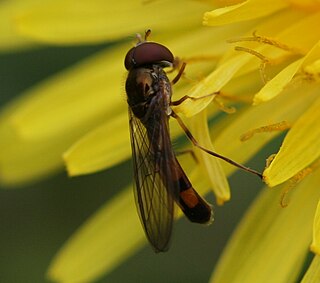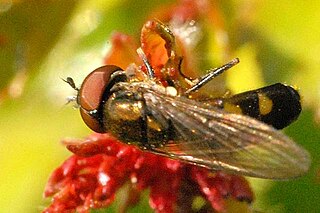
Hover flies, also called flower flies or syrphid flies, make up the insect family Syrphidae. As their common name suggests, they are often seen hovering or nectaring at flowers; the adults of many species feed mainly on nectar and pollen, while the larvae (maggots) eat a wide range of foods. In some species, the larvae are saprotrophs, eating decaying plant and animal matter in the soil or in ponds and streams. In other species, the larvae are insectivores and prey on aphids, thrips, and other plant-sucking insects.

Episyrphus balteatus, sometimes called the marmalade hoverfly, is a relatively small hoverfly (9–12 mm) of the Syrphidae family, widespread throughout the Palaearctic region, which covers Europe, North Asia, and North Africa. The upper side of the abdomen is patterned with orange and black bands. Two further identification characters are the presence of secondary black bands on the third and fourth dorsal plates and faint greyish longitudinal stripes on the thorax. Its color patterns may appear wasp-like to other animals, such as birds, protecting it from predation.

Eristalinae are one of the four subfamilies of the fly family Syrphidae, or hoverflies. A well-known species included in this subfamily is the dronefly, Eristalis tenax.

Platycheirus clypeatus is a species of hoverfly. It is found across the Palearctic and in the Nearctic. The larvae feed on aphids. Adults are usually found on the edges of woodland or scrub, heath or along hedgerows where they visit a wide range of flowers.

Eupeodes luniger is a common species of hoverfly.

Melanostoma scalare, the chequered hoverfly, is a very common species of hoverfly.

Melanostoma mellinum is a very common species of hoverfly found in many parts of Britain, Europe including the Mediterranean basin and North Africa, the East Palearctic, and North America.

Baccha elongata is a species of hoverfly in the genus Baccha.

Platycheirus manicatus is a species of hoverfly. It is found across the Palearctic and in Alaska.

Platycheirus splendidus is a species of hoverfly. It is found in many parts of Britain and Europe.

Ferdinandea is a genus of syrphid flies or hoverflies in the family Syrphidae. There are about 16 described species in Ferdinandea.
Hammerschmidtia is a Holarctic genus of hoverflies whose larvae live in sap under the bark of freshly fallen trees.

Lejogaster is a genus of small, shiny, metallic hoverflies.

Parhelophilus is a genus of hoverflies. They are slightly smaller than flies of the genus Helophilus, and have a Holarctic distribution.

Brachypalpoides is a genus of hoverflies, from the family Syrphidae, in the order Diptera.

Pipizini is a tribe of small to medium-sized generally black hoverflies, although some species also have orange spots on their abdomen. This nondescript colouring can lead to some species being confused with other dark hoverflies from other tribes. The lack of a facial knob is a good defining feature which separates them from most of these other hoverflies. As with other species in the subfamily Syrphinae the larvae feed on aphids though there seems to be a preference for wax-secreting aphids e.g. Pemphigidae.

Platycheirus angustatus is a species of hoverfly. It is found in many parts of the Palearctic, and in the Nearctic.
Platycheirus aurolateralis is a species of hoverfly. Only described in 2002, it has so far only been recorded in southern Britain.
Platycheirus ramsaerensis is a Palearctic species of hoverfly. It is found along the parts of northern Europe that face the Atlantic. It is a member of the Platycheirus clypeatus group

Eumerus funeralis or lesser bulb fly is a species of Hoverfly, from the family Syrphidae, in the order Diptera. E. funeralis appears in Peck (1988) as a synonym of E. strigatus (Fallen), but was reinstated as the correct name for tuberculatus Rondani, sensu auctorum by Speight et al. (1998).

















